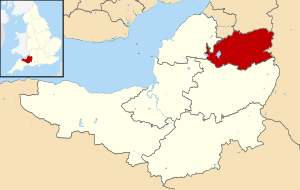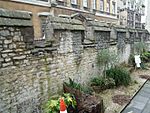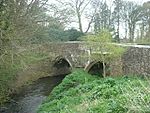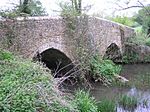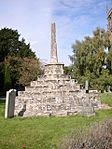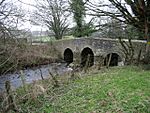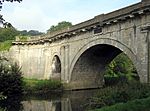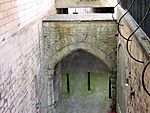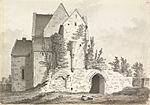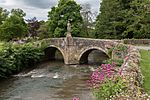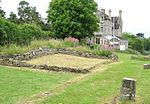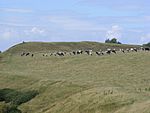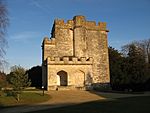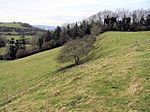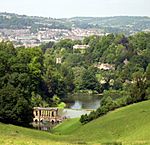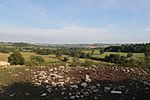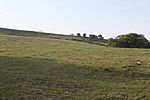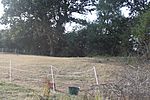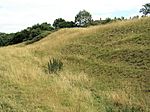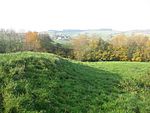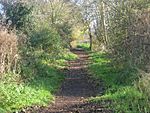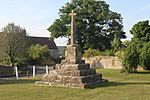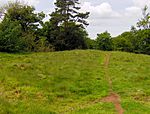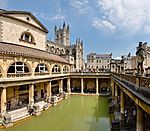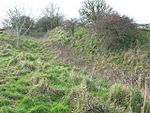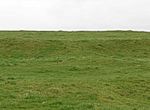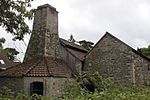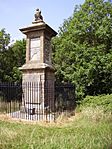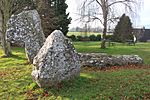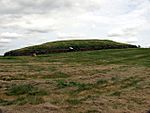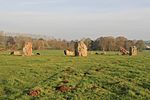Scheduled monuments in Bath and North East Somerset facts for kids
Bath and North East Somerset (commonly referred to as BANES or B&NES) is a unitary authority created on 1 April 1996, following the abolition of the County of Avon, which had existed since 1974. Part of the ceremonial county of Somerset, Bath and North East Somerset occupies an area of 220 square miles (570 km2), two-thirds of which is green belt. It stretches from the outskirts of Bristol, south into the Mendip Hills and east to the southern Cotswold Hills and Wiltshire border. The city of Bath is the principal settlement in the district, but BANES also covers Keynsham, Midsomer Norton, Radstock and the Chew Valley. The area has a population of 170,000, about half of whom live in Bath, making it 12 times more densely populated than the rest of the area.
A scheduled monument is a nationally important archaeological site or monument which is given legal protection by being placed on a list (or "schedule") by the Secretary of State for Culture, Media and Sport; English Heritage takes the leading role in identifying such sites. The legislation governing this is the Ancient Monuments and Archaeological Areas Act 1979. The term "monument" can apply to the whole range of archaeological sites, and they are not always visible above ground. Such sites have to have been deliberately constructed by human activity. They range from prehistoric standing stones and burial sites, through Roman remains and medieval structures such as castles and monasteries, to later structures such as industrial sites and buildings constructed for the World Wars or the Cold War.
There are 58 scheduled monuments in Bath and North East Somerset. Some of the oldest are Neolithic, including the Stanton Drew stone circles and several tumuli. The Great Circle at Stanton Drew is one of the largest Neolithic monuments ever built, and the second largest stone circle in Britain (after Avebury). The date of construction is not known but is thought to be between 3000 and 2000 BCE, which places it in the Late Neolithic to Early Bronze Age. There are also several Iron Age hillforts such as Maes Knoll, which was later incorporated into the medieval Wansdyke defensive earthwork, several sections of which are included in this list. The Romano-British period is represented with several sites, most notably the Roman Baths and city walls in Bath. More recent sites include several bridges which date from the Middle Ages to the 18th-century Palladian bridge in Prior Park Landscape Garden. Dundas Aqueduct, built in 1805 to carry the Kennet and Avon Canal, is the most recent site in the list. The monuments are listed below using the names given in the English Heritage data sheets.
Monuments
| Name | Location | Type | Completed | Grid ref. Geo-coordinates |
Notes | Entry number | Image | Ref. |
|---|---|---|---|---|---|---|---|---|
| Bath city walls | Bath | Defensive wall | Romano-British | ST 74941 64886 51°22′48″N 2°21′30″W / 51.3801°N 2.3583°W |
Bath's first walls were built by the Romans and then extended by the Anglo-Saxons to create a fortified burh. | 1007017 | ||
| Bathampton Camp | Bathampton | Univallate hill fort | Iron Age | ST7741965033 51°23′05″N 2°19′34″W / 51.3847°N 2.3262°W |
Bathampton Camp may have been a univallate Iron Age hill fort or stock enclosure. A rectangular enclosure, which is approximately 650 metres (2,133 ft) (east-west) by 500 metres (1,640 ft) (north-south), has been identified which may be a Medieval earthwork. | 1002480 | ||
| Bathford Bridge | Bathford | Bridge | 1665 | ST 78651 67004 51°24′06″N 2°18′30″W / 51.4017°N 2.3083°W |
A stone arched bridge, which was built in 1665, carrying the A363, over the Bybrook River close to its confluence with the River Avon. | 1004515 | ||
| Bowl barrow, Hinton Charterhouse | Hinton Charterhouse | Bowl barrow | Late Neolithic to Bronze Age | ST 77098 59208 51°19′53″N 2°19′48″W / 51.3315°N 2.3301°W |
The barrow is 74 yards (68 m) in circumference and 1.2 metres (3 ft 11 in) high. Roman coins have been found at the site. | 1002474 | ||
| Bowl barrow 90 m south-west of Bicknell Farm | Nempnett Thrubwell | Bowl barrow | Iron Age | ST 51641 62732 51°21′41″N 2°41′46″W / 51.3615°N 2.6960°W |
The bowl barrow is 26 metres (85 ft) in diameter and 2 metres (6 ft 7 in) high. In the middle Ages a windmill was built on the mound. | 1008294 | ||
| Bowl barrow 400 m west of Bellevue House | Nempnett Thrubwell | Bowl barrow | Late Neolithic to Bronze Age | ST 51234 60246 51°20′21″N 2°42′05″W / 51.3392°N 2.7015°W |
This barrow is 12 metres (39 ft) in diameter and 1.2 metres (3 ft 11 in) high. It was surrounded by a ditch but this has been filled in. | 1008183 | ||
| Bridge at Stanton Drew | Stanton Drew | Bridge | 13th or 14th century | ST 59679 63444 51°22′07″N 2°34′51″W / 51.3686°N 2.5807°W |
A stone bridge, with two pointed arches, over the River Chew. | 1004519 | ||
| Camerton Romano-British town and associated Prehistoric and early medieval monuments | Camerton | Vicus | Romano-British | ST 68646 56623 51°18′20″N 2°27′01″W / 51.3056°N 2.4503°W |
The site of a small Romano-British settlement. There is also evidence of prehistoric and medieval use. | 1013881 | ||
| Chewton Keynsham packhorse bridge | Chewton Keynsham | Packhorse bridge | Middle Ages | ST 65465 66437 51°23′45″N 2°29′52″W / 51.3959°N 2.4978°W |
A stone two arch bridge over the River Chew. | 1004518 | ||
| Churchyard cross in St Andrew's churchyard | Chew Magna | Cross | 15th century | ST 57674 63198 51°22′00″N 2°36′35″W / 51.3667°N 2.6097°W |
A limestone cross, from which the head is missing, on an octagonal base with six steps. | 1017570 | ||
| Compton Dando Bridge | Compton Dando | Bridge | Late Middle Ages | ST 64701 64686 51°22′48″N 2°30′31″W / 51.3801°N 2.5086°W |
A stone bridge with three arches, over the River Chew. | 1004517 | ||
| Culverhay Castle | Englishcombe | Ringwork | 11th to 13th century | ST 71906 63018 51°22′00″N 2°24′15″W / 51.3667°N 2.4043°W |
A ringwork ditch and bank, up to 5 feet (1.5 m) deep. During the first half of the 13th century a stone circular keep and low curtain wall was built at the castle. | 1006992 | ||
| Deserted medieval farmstead NE of Northwick | Norton Malreward | Earthwork | Middle Ages | ST 59148 66175 51°23′38″N 2°35′23″W / 51.3940°N 2.5897°W |
Traces of several buildings form the 13th and 14th century have been identified. The site was reoccupied in the 18th century. | 1004524 | ||
| Dundas Aqueduct | Monkton Combe | Aqueduct | 1805 | ST 78460 62533 51°21′42″N 2°18′38″W / 51.3616°N 2.3105°W |
Built between 1797 and 1801, the Dundas Aqueduct carries the Kennet and Avon Canal over the River Avon and the Wessex Main Line railway. It is 150 yards (137.2 m) long with three arches built of Bath Stone, with Doric pilasters, and balustrades at each end. | 1005631 | ||
| Eastgate, Bath | Bath | City walls | Middle Ages | ST 75173 64872 51°22′56″N 2°21′29″W / 51.3823°N 2.3581°W |
The only one of the medieval gates into the city which has survived. | 1007018 | ||
| Fairy Toot | Nempnett Thrubwell | Long barrow | Neolithic | ST 52056 61808 51°21′13″N 2°41′29″W / 51.3536°N 2.6913°W |
The Fairy Toot is an extensive oval barrow of the Severn-Cotswold tomb type which consist of precisely-built, long trapezoid earth mounds covering a burial chamber. | 1008181 | ||
| Hautville's Quoit | Stanton Drew | Recumbent stone | Neolithic | ST 60169 63795 51°22′17″N 2°34′31″W / 51.3715°N 2.5752°W |
A (now recumbent) standing stone close to the Stanton Drew stone circles. It was described by William Stukeley in 1723 as being 13 feet (4.0 m) long, it is now about half that length. | 1002475 | ||
| Hinton Priory | Hinton Charterhouse | Priory | 1232 | ST 77806 59157 51°19′50″N 2°19′17″W / 51.3306°N 2.3215°W |
A Carthusian priory established in the 13th century and suppressed as part of the dissolution of the monasteries in 1539. The chapter house, prior's cell and refectory survive as agricultural buildings belonging to the sixteenth century mansion, Hinton Abbey. Surviving earthworks from the great cloister are still visible in an orchard and paddocks. | 1007014 | ||
| Iford Bridge | Freshford & Hinton Charterhouse | Bridge | c. 1400 | ST 80023 58896 51°19′44″N 2°17′17″W / 51.3288°N 2.2881°W |
A stone bridge with two arches carrying a minor road over the River Frome. | 1007007 | ||
| Keynsham Abbey | Keynsham | Abbey | 1170 | ST 65599 68821 51°25′02″N 2°29′46″W / 51.4172°N 2.4961°W |
The abbey was founded around 1170 and survived until 1539. After the dissolution the site was occupied by a house which was itself demolished in 1776. | 1005416 | ||
| Lansdown camp | Charlcombe | Earthwork | Possibly Iron Age | ST 72123 69866 51°25′37″N 2°24′10″W / 51.4270°N 2.4027°W |
The remains of a bank and ditch from the Iron Age which was probably a stock enclosure. | 1002482 | ||
| Large irregular stone circle at Stanton Drew south east of Church Farm | Stanton Drew | Stone circle | Neolithic | ST 59919 63070 51°21′55″N 2°34′37″W / 51.3653°N 2.5770°W |
The largest stone circle is the Great Circle, 113 metres (371 ft) in diameter and the second largest stone circle in Britain (after Avebury). | 1007915 | ||
| Large univallate hillfort with outworks 800 m west of White Cross | West Harptree | Univallate hill fort | Iron Age | ST 58247 58497 51°19′33″N 2°35′34″W / 51.3259°N 2.5927°W |
A univallate Iron Age hillfort which has been investigated three times. In 1955 by the University of Bristol Spelaeological Society archaeologists found evidence of postholes, ditches, and pits inside the fort. | 1004526 | ||
| Large univallate hillfort with a bowl barrow and pillow mounds 970 m west of The Bungalow | North Stoke | Univallate hill fort | Iron Age | ST 70885 68879 51°25′06″N 2°25′12″W / 51.4182°N 2.4201°W |
A hill fort, containing bowl barrows and pillow mounds, surrounded by a bank and ditch, which are now buried. | 1004677 | ||
| Lock Up, Monkton Combe | Monkton Combe | Village lock-up | 18th century | ST 77358 61957 51°21′22″N 2°19′34″W / 51.3562°N 2.3261°W |
A small stone building with a domed roof. Probably built around 1776. | 1004541 | ||
| Maes Knoll | Norton Malreward | Hill fort | Iron Age | ST 60001 65961 51°23′32″N 2°34′32″W / 51.3921°N 2.5756°W |
The hillfort, which is approximately 390 by 84 feet (119 m × 26 m), and 45 feet (14 m) in height, covering 20 acres (8.1 ha), consists of a fairly large flat open area, roughly triangular in shape, that has been fortified by ramparts and shaping of the steep-sided hilltop around the northern, eastern and southwestern sides of the hill. It rises to an altitude of 197 metres (646 ft) above sea level. | 1005424 | ||
| Newton St Loe Castle | Newton St Loe | Fortified manor house | 12th century | ST 69408 64003 51°22′27″N 2°26′27″W / 51.3743°N 2.4409°W |
Originally built as a fortified manor house, probably in the 12th century, surrounded by Newton Park, then a medieval deer park. At the start of the 14th century, a keep was built on the site, creating a rectangular, courtyard castle with four corner towers, protected by a ditch on three sides. | 1006993 | ||
| Oval enclosure, possibly Iron Age, SW of Stowey House | Stowey | Ringwork | Iron Age | ST 59738 59287 51°19′52″N 2°34′45″W / 51.3312°N 2.5793°W |
The ringwork has a 3 metres (9.8 ft) wide bank and 7 metres (23 ft) wide ditch. There is limited evidence that it was the site of a castle. | 1004606 | ||
| Palladian Bridge, Prior Park, Bath | Prior Park Landscape Garden | Bridge | 1750s | ST 76076 63326 51°22′07″N 2°20′42″W / 51.3685°N 2.3450°W |
The bridge crosses a dam between two lakes. It is copied from a similar bridge at Wilton House and has a pulvinated frieze. | 1004514 | ||
| Part of the linear boundary known as the Wansdyke 425 m south of New Barn Farm | Norton Malreward | Earthwork | Prehistoric but modified in the Early Middle Ages | ST6103865517 51°23′14″N 2°33′41″W / 51.3873°N 2.5613°W |
A bank and ditch. Part of the surviving remains of the Wansdyke. | 1003066 | ||
| Part of the linear boundary known as the Wansdyke: section E of Maes Knoll camp | Norton Malreward | Earthwork | Prehistoric but modified in the Early Middle Ages | ST 60361 65898 51°23′27″N 2°34′16″W / 51.3907°N 2.5711°W |
A bank and ditch. Part of the surviving remains of the Wansdyke. | 1007009 | ||
| Part of the linear boundary known as the Wansdyke 585 m north of Tuckingmill Farm | Compton Dando | Earthwork | Prehistoric but modified in the Early Middle Ages | ST 65393 64400, 51°22′47″N 2°30′14″W / 51.3798°N 2.5038°W |
A bank and ditch. Part of the surviving remains of the Wansdyke. | 1007004 | ||
| Part of the linear boundary known as the Wansdyke 210 m north west of Cottles | Publow | Earthwork | Prehistoric but modified in the Early Middle Ages | ST 62219 65263 51°23′07″N 2°32′51″W / 51.3854°N 2.5475°W |
A bank and ditch. Part of the surviving remains of the Wansdyke. | 1007010 | ||
| Part of the linear boundary known as the Wansdyke 375 m south east of Knowle Farm | Compton Dando | Earthwork | Prehistoric but modified in the Early Middle Ages | ST6446664935 51°22′56″N 2°30′43″W / 51.3823°N 2.5120°W |
A bank and ditch. Part of the surviving remains of the Wansdyke. | 1004523 | ||
| Part of the linear boundary known as the Wansdyke 420 m south west of Barrowmead Cottage | Englishcombe | Earthwork | Prehistoric but modified in the Early Middle Ages | ST7268162210 51°21′30″N 2°23′37″W / 51.3583°N 2.3937°W |
A bank and ditch. Part of the surviving remains of the Wansdyke. | 1007005 | ||
| Part of the linear boundary known as the Wansdyke 285 m north west of Manor Farm | Englishcombe | Earthwork | Prehistoric but modified in the Early Middle Ages | ST 71306 62936 51°21′56″N 2°25′06″W / 51.3655°N 2.4184°W |
A bank and ditch. Part of the surviving remains of the Wansdyke. | 1007006 | ||
| Part of the linear boundary known as the Wansdyke 530 m north west of Park Farm | Newton St Loe | Earthwork | Prehistoric but modified in the Early Middle Ages | ST6890363597 51°22′10″N 2°26′29″W / 51.3695°N 2.4413°W |
A bank and ditch. Part of the surviving remains of the Wansdyke. | 1007008 | ||
| Part of the linear boundary known as the Wansdyke: section 1230 yd (1120 m) eastwards from Burnt House Inn | Bath | Earthwork | Prehistoric but modified in the Early Middle Ages | ST 74053 61803 51°21′17″N 2°22′26″W / 51.3547°N 2.3740°W |
A bank and ditch. Part of the surviving remains of the Wansdyke. | 1007003 | ||
| Part of a Roman road 565 m north of Abbey Farm | Hinton Charterhouse | Earthwork | Romano-British | ST 77083 59521 51°20′03″N 2°19′49″W / 51.3343°N 2.3303°W |
The remains of a Roman road part of which is visible as an Earthwork; however some sections are only visible as crop marks on aerial photographs. | 1005421 | ||
| Queen Charlton village cross | Queen Charlton | Cross | 15th century | ST 63418 67057 51°24′06″N 2°31′38″W / 51.4018°N 2.5271°W |
A stone cross on a base with five steps. | 1015510 | ||
| Richmont Castle | East Harptree | Earthwork | 11th century | ST 56137 55835 51°18′00″N 2°37′44″W / 51.3001°N 2.6289°W |
The 11th century castle had a single bailey on the south side, possibly making use of an existing Iron Age fortification. Later an inner bailey was added and a circular keep surrounded by a park. The castle was ruined and abandoned by the 1540s and little apart from earthworks are visible today. | 1006991 | ||
| Roman Baths and site of Roman town, Bath | Bath | Baths | Romano-British | ST 74846 64803 51°22′51″N 2°21′34″W / 51.3809°N 2.3595°W |
A Roman site for public bathing which used natural warm springs and surrounding buildings. All of the Roman features are now beneath street level. The buildings above street level date from the 19th century. | 1004678 | ||
| Roman camp 405 m west of The Bungalow | North Stoke | Earthwork | Romano-British | ST7142968918 51°25′07″N 2°24′44″W / 51.4186°N 2.4123°W |
A rectangular enclosure approximately 100 metres (330 ft) long and 55 metres (180 ft) wide internally, surrounded by a 1 metre (3 ft 3 in) high stony bank. | 1005422 | ||
| Roman Settlement at Keynsham Hams, former Cadbury's Factory | Keynsham | Roman villa | Romano-British | ST6535769411 51°25′23″N 2°29′41″W / 51.4231°N 2.4946°W |
The remains of a Roman settlement, most of which is now beneath ground level. It is within the grounds of an early-20th-century industrial site. | 1416459 | ||
| Roman villa at Upper Hayes | Wellow | Earthwork | Romano-British | ST7142968918 51°19′13″N 2°23′29″W / 51.3204°N 2.3915°W |
The site of a Roman villa which had two corridors, mosaics, hypocausts and baths is bow marked by posts in the ground. A relief from the site is now in the British Museum. The site is on the English Heritage list of Heritage at Risk. | 1007002 | ||
| Romano-British settlement E of Sir Bevil Granville's Monument | Charlcombe | Earthwork | Romano-British | ST7245870244 51°25′50″N 2°23′51″W / 51.4305°N 2.3976°W |
The site of a Roman settlement or temple and associated buildings possibly used for iron and pewter manufacture. Several stone coffins were found at or near the site. The earthworks of the site are visible in aerial photographs. | 1004527 | ||
| Round House, Pensford | Pensford | Village lock-up | 18th century | ST 61993 63762 51°22′18″N 2°32′50″W / 51.3716°N 2.5472°W |
An octagonal eighteenth-century village lock-up. | 1005423 | ||
| Saltford Brass Mill | Saltford | Brass mill | 1720s | ST 68724 67011 51°24′04″N 2°27′04″W / 51.4011°N 2.4511°W |
The site includes a battery mill and a complete annealing furnace. There are also the remains of the water wheels initially used to power the machinery, one of which is still in working order. The battery mills were supplemented by rolling mills between 1760 and 1830. The mill ceased production in 1924. | 1004607 | ||
| Sir Bevil Grenville's Monument | Lansdown | Monument | 1720 | ST 72190 70345 51°25′53″N 2°23′58″W / 51.4314°N 2.3994°W |
Erected in 1720 to commemorate the heroism of the Civil War Royalist commander Sir Bevil Grenville who on 5 July 1643 fell mortally wounded at the Battle of Lansdowne. The monument is of ashlar stone masonry, 25 feet (7.6 m) high, in the English Baroque style. | 1015110 | ||
| Slight univallate hillfort 190 m north west of Westleigh | Batheaston | Univallate hill fort | Iron Age | ST 76856 67925 51°24′36″N 2°20′03″W / 51.41°N 2.3342°W |
Solsbury Hill is a small flat-topped hill and the site of an Iron Age hill fort occupied between 300 BC and 100 BC. The rampart was 20 feet (6 m) wide and the outer face was at least 12 feet (4 m) high. It is a possible location of the Battle of Badon. It was acquired by the National Trust in 1930. People protesting against the building of an A46 bypass road cut a small turf maze into the hill. It is also the inspiration for rock musician Peter Gabriel's first solo single in 1977. | 1002481 | ||
| Slight univallate hillfort 125 m west of Tunley Farm | Camerton | Univallate hill fort | Late Bronze Age to Iron Age | ST 68346 59176 51°19′51″N 2°27′21″W / 51.3308°N 2.4557°W |
The site of a Univallate hill fort. Some earthworks remain as a bank and ditch. | 1004525 | ||
| Stantonbury camp and adjacent sections of Wansdyke | Stanton Prior | Hill fort | Iron Age | ST 67450 63711 51°22′15″N 2°28′20″W / 51.3708°N 2.4722°W |
The hillfort, which is at the top of an isolated outcrop of Oolitic Limestone, is on the route of the Wansdyke. Several iron agricultural implements, recovered from the site, including blades of sickles or pruning hooks and the iron tip from an ard, are now in the collection of the British Museum. The site is on the English Heritage Heritage at Risk Register as being in danger of deterioration because of extensive animal burrowing. | 1002487 | ||
| Stone cove at Stanton Drew 25 m south west of St Mary's Church | Stanton Drew | Standing stone | Neolithic | ST 59750 63100 51°21′56″N 2°34′47″W / 51.3656°N 2.5796°W |
a cove of two standing stones with a recumbent slab between them, which can be found in the garden of the Druid's Arms public house. All are of different heights, the stone to the north east being 4.4 metres (14 ft) the south western 3.1 metres (10 ft), and the north eastern 1.4 metres (4 ft 7 in). The stones of The Cove are mineralogically different from those in the nearby Stanton Drew stone circles. A long barrow burial chamber has been found under the stones of The Cove. It is thought that this predates the erection of the stones by approximately a thousand years. | 1007916 | ||
| Stoney Littleton Long Barrow | Wellow | Long barrow | Neolithic | ST 73492 57208 51°18′48″N 2°22′53″W / 51.3133°N 2.3813°W |
A Neolithic chambered tomb with multiple burial chambers, of the Severn-Cotswold tomb type. The barrow is about 30 metres (98 ft) in length and 15 metres (49 ft) wide at the south-east end, it stands nearly 3 metres (10 ft) high. Internally it consists of a 12.8 metres (42 ft) long gallery with three pairs of side chambers and an end chamber. There is a fossil ammonite decorating the left-hand doorjamb. | 1007910 | ||
| Two stone circles and two stone avenues at Stanton Drew, east of Court Farm | Stanton Drew | Henge | Neolithic | ST 60034 63272 51°22′04″N 2°34′31″W / 51.3678°N 2.5753°W |
The largest stone circle is the Great Circle, 113 metres (371 ft) in diameter. The date of construction is not known but is thought to be between 3000 and 2000 BCE. The Great Circle was surrounded by a ditch and is accompanied by smaller stone circles to the north east and south west. Some of the stones are still vertical, but the majority are now recumbent and some are no longer present. | 1007911 | ||
| Tun Bridge | Chew Magna | Bridge | 15th century | ST 57693 62905 51°21′49″N 2°36′33″W / 51.3637°N 2.6091°W |
A 15th century stone bridge with three pointed arches. It carries a minor round over the River Chew. | 1004516 | ||
| Two round barrows north of Blathwayt Arms | Charlcombe | Round barrows | Bronze Age | ST 72520 68706 51°24′59″N 2°23′46″W / 51.4165°N 2.3962°W |
Some earthwork remains of bowl barrows, highest of which is 2 metres (6 ft 7 in) high. | 1002471 | ||
| Ubley Manor House | Ubley | Earthwork | 14th century | ST 52904 58338 51°19′15″N 2°40′31″W / 51.3209°N 2.6752°W |
Some walling remains from a 14th century manor house which was largely demolished in the 20th century. | 1004543 |


